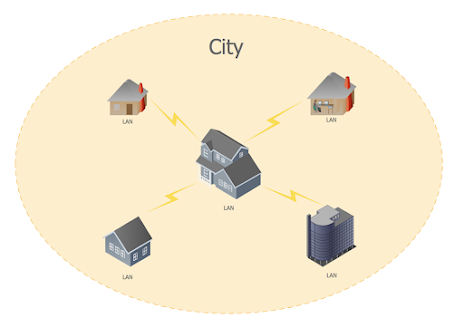Types of Computer Network
What are the types of computer network?
- PAN (Personal Area Network)
A computer network used to interconnect devices centered on an individual workplace. PAN can be used for connecting personal devices, which typically involve a mobile computer, a cell phone, and/or a handheld computing device such as PDA. The network is used to transfer files including email, calendar appointments, digital photos, and music.
Personal area networks can be created using USB cables, Bluetooth, infrared, or other wireless technologies. It generally covers a network range of less than 10 meters and is viewed as a special type of Local Area Network.
(Note: Distance range is up to 10 meters)
- LAN (Local Area Network)
A type of network where two to as much as hundreds of computers are connected with each other using a network sharing device known as a hub or switch to enable sharing of files, printers, and other resources.
Application of LANs:
The LANs' primary functions are linking mobile and desktop computers together and providing shared access to printers, file servers, Internet connection and many other services. The birth of LANs was brought about by a simple goal. How do you share expensive resources and equipment within a group of computer users? What if your employees needed to print their work on laser printers?
Imagine the cost of having to purchase separate printers to connect to individual PCs. Not everyone really needs to print at the same time yet generating hard copies is still a vital part of their work; thus, they need a printer. This doesn't mean though that the company should invest in acquiring laser printers for each individual as these printers will be idle most of the time. The same scenario applies to Internet access. It would be foolish to provide each and every computer with its own dedicated Internet service provider. Why not share one subscription among several users? Even more importantly, workplaces now employ specialized computer applications that read and write to a common relational database management system. This means that a database server is set up and shared among several users to consolidate all information into one common data pool. This would be impossible if the computers are not connected through a LAN.
The most common type LAN hardware is known as Ethernet. In its simplest form, it consists of a single cable with hosts attached to it through connectors, taps, or transceivers. Simple Ethernets are relatively inexpensive to install, which together with a net transfer rate of 10, 100, or even 1,000 Megabits per second accounts for much of its popularity.
Local area networks can be created using Ethernet cable and Wi-Fi.
(Note: Distance range is up to 100 meters)
- MAN (Metropolitan Area Network)
A MAN is a larger network than a LAN. It involves connecting several networks together that reside within a city, town, or metropolis. On a MAN, users may be several miles apart, but resources appear on the network just as if they were located within the same building.
Metropolitan area networks can be created using modem, and copper cable/fiber optic.
(Note: Distance range is up to 5 to 50 kms)
- WAN (Wide Area Network)
Simply a computer network consisting of interconnected LANs. It is usually dispersed over a very wide area, and it is not uncommon to see WANs reaching across continents to link office networks with one another in several international branch offices. Setting up a WAN involves the addition of a specialized network bridge called a router to your network, and the use of a transmission medium such as a dedicated leased line from a telecommunications service provider or telco. More modern solutions use a regular Internet connection and install a Virtual Private Network (VPN) device to securely interconnect two networks together. A Wide Area Network assures the organization of better security since the network can be centrally managed despite the wide geographic reach. Data, voice, and even video communications can be secured with no threat from outside breaches. The company can provide its own secured email service, servers can securely communicate with one another, and file transfers are faster since they operate on a dedicated link. The Internet is considered the widest of all WANs and is the biggest computer network.
Wide area networks Can be created using optic wire, microwaves, and satellite.
(Note: Distance range is up to 50 to 100,000 kms)
Sources: image from tutorialandexample.com/types-of-network https://www.conceptdraw.com/How-To-Guide/personal-area-networks https://www.smarts4k.com/lan-wiring-diagram/ https://www.conceptdraw.com/How-To-Guide/metropolitan-area-networks https://www.reddit.com/r/AccidentalRacism/comments/b34o6x/a_wan_network_diagram_i_was_doing_genuinely_didnt/?rdt=55057 and text from D Whiz in Connecting Devices and Networking Book (Published by Rex Book Store)






.png)
Comments
Post a Comment